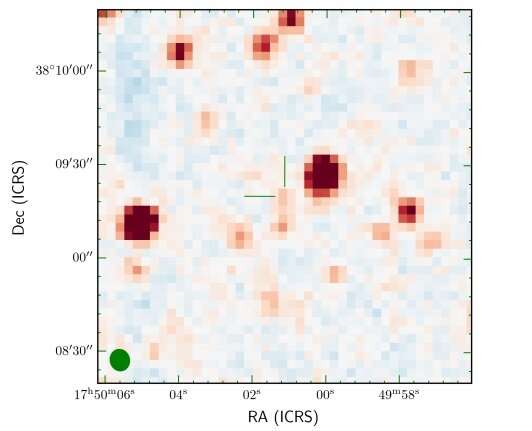Using the Low-Frequency Array (LOFAR) radio telescope, an international team of astronomers has discovered a new radio source that turns out to be a cold brown dwarf. The object, designated BDR 1750+3809, is so far the first radio-selected brown dwarf, which proves that such sources can be also directly identified by sensitive wide-area radio surveys. The finding is reported in a paper published October 5 on arXiv.org.
Brown dwarfs are intermediate objects between planets and stars, occupying the mass range between 13 and 80 Jupiter masses. They are known to display optical aurorae and the associated auroral radio emission powered by the electron cyclotron maser instability. Therefore, radio telescopes have the potential to uncover the presence of new brown dwarfs.
Of special interest are low-frequency observations and wide-area surveys, as they are capable of identifying many radio-emitting sources. In order to detect coherent stellar radio emission, astronomers look for circularly polarized (CP) radio sources. Studies show that radio emitters with high CP fraction could be stars, brown dwarfs and planets, or even pulsars. However, low-frequency searches for brown dwarfs have so far been unsuccessful.
Now, a group of astronomers led by Harish Vedantham of the University of Groningen in the Netherlands, has made a breakthrough in such searches. They report that BDR 1750+3809, a radio source identified by LOFAR, is a substellar object. Its brown dwarf status was confirmed by follow-up near-infrared photometric and spectroscopic observations.
“BDR 1750+3809 was discovered as a radio source in an eight-hour LOFAR exposure between 120 and 167 MHz with a high average CP fraction of about 96 percent,” the astronomers explained.
According to the paper, the spectrum of BDR 1750+3809 clearly shows strong water and methane absorption bands that are indicative of spectral type T. All in all, the results allowed the researcher to classify the object as a cold methane dwarf of spectral type T6.5.
The distance to BDR 1750+3809 was estimated to be approximately 212 light years and the magnetic field strength at the emitter site in this brown dwarf was measured to be at least 25 G. The brightness temperature of the emitter in BDR 1750+3809 was calculated to be at a level of 1 quadrillion K/x∗2, where x∗ is the radius of the emitter in units of the characteristic brown dwarf radius of about 70,000 km.
Moreover, the radio spectral luminosity of BDR 1750+3809 was found to be around 5.0 quadrillion erg/s/Hz. The astronomers noted that this is over two orders of magnitude larger than that of the known brown dwarfs of comparable spectral type. They explained that this could be due to a preferential geometric alignment or an electrodynamic interaction with a close companion.
Summing up the results, the scientists added that the discovery of radio-selected BDR 1750+3809, gives hopes that low-frequency observations could be also successful in the future when it comes to detection of magnetospheres of extrasolar planets.
Astronomers measure wind speed on a brown dwarf
More information:
Direct radio discovery of a cold brown dwarf, arXiv:2010.01915 [astro-ph.EP] arxiv.org/abs/2010.01915
2020 Science X Network
Citation:
Radio observations detect new brown dwarf (2020, October 13)
retrieved 13 October 2020
from https://phys.org/news/2020-10-radio-brown-dwarf.html
This document is subject to copyright. Apart from any fair dealing for the purpose of private study or research, no
part may be reproduced without the written permission. The content is provided for information purposes only.



